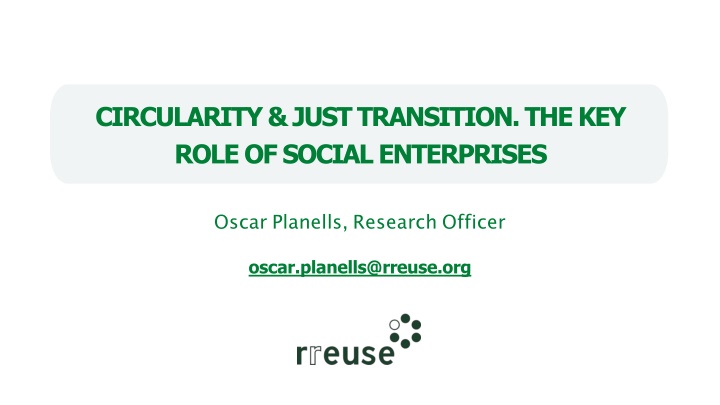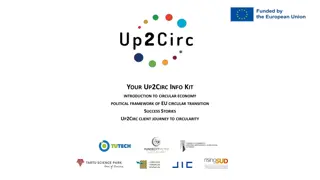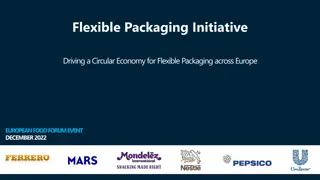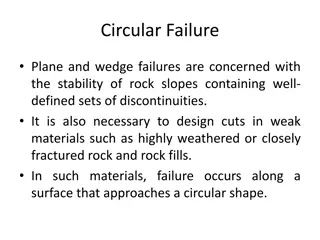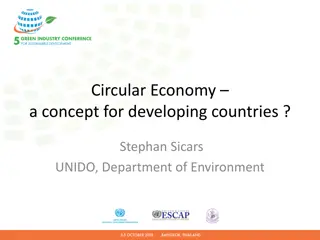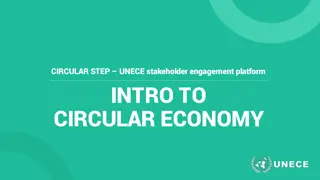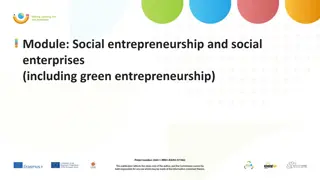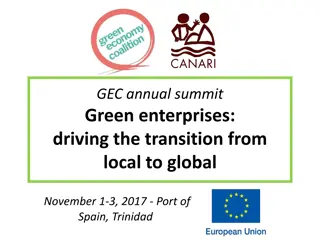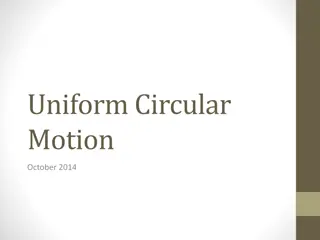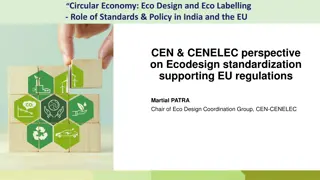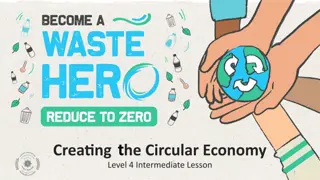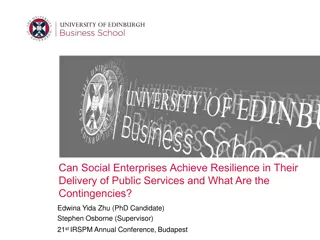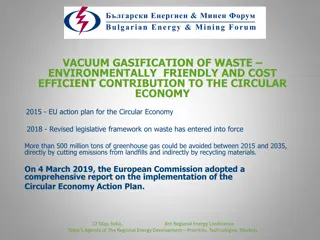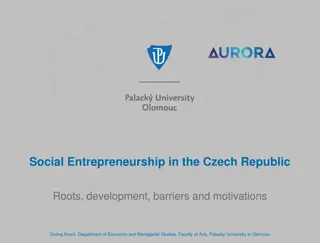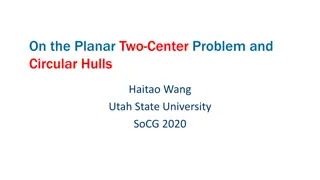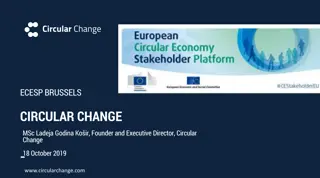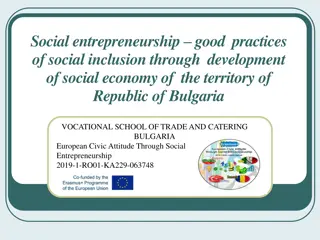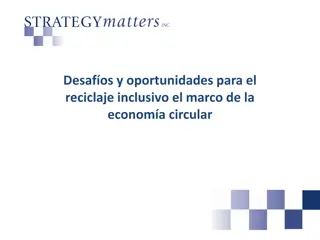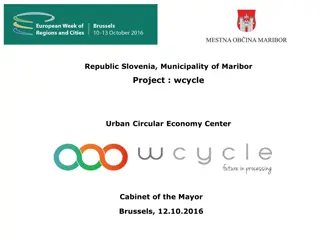Social Enterprises and Circular Economy: The Power of Re-use
Social enterprises play a key role in the circular economy by promoting re-use practices that have a significant environmental impact, such as saving CO2 emissions and creating jobs. Through initiatives like preparing WEEE for re-use and re-using steel sections, social enterprises contribute to both environmental sustainability and social impact, providing employment opportunities for disadvantaged workers and promoting lifelong learning. Best practices, such as inclusive circular jobs and transferable circular skills programs, highlight the success stories of social enterprises in promoting a sustainable and inclusive economy.
Download Presentation

Please find below an Image/Link to download the presentation.
The content on the website is provided AS IS for your information and personal use only. It may not be sold, licensed, or shared on other websites without obtaining consent from the author.If you encounter any issues during the download, it is possible that the publisher has removed the file from their server.
You are allowed to download the files provided on this website for personal or commercial use, subject to the condition that they are used lawfully. All files are the property of their respective owners.
The content on the website is provided AS IS for your information and personal use only. It may not be sold, licensed, or shared on other websites without obtaining consent from the author.
E N D
Presentation Transcript
CIRCULARITY & JUST TRANSITION. THE KEY ROLE OF SOCIAL ENTERPRISES Oscar Planells, Research Officer oscar.planells@rreuse.org
ENVIRONMENTAL IMPACT OF RE-USE Re-use of WEEE saves 1,14 tonnes of CO2 per tonne, while recycling saves 0,85 and landfilling emits 0,02 [1] According to UNEP, even if metals recycling increased, rising global demand would remain a huge environmental challenge [5] 13%-16% of WEEE can immediately be prepared for re-use. Further re-use potential of 13%-29% could be achieved mainly through changes to the mode of collection and storage[4]
ENVIRONMENTAL IMPACT OF RE-USE Re-using structural steel sections decreases the environmental impact by 96%, compared to recycling [6] However, only 5% of light structural steel and 7% of heavy structural sections/ tubes are reused[6] When new steel sections consist of around 60% recycled content, the environmental impact is still 25 times higher than re-using steel sections [7]
SOCIAL IMPACT OF RE-USE Preparation for re-use of WEEE creates between 60 and 140 jobs per 1,000 tones[2,3] 65% of disadvantaged workers managed to find employment or further training opportunities following their job placements in social enterprises Social enterprises active in the circular economy also key in providing circular skills development and lifelong learning opportunities for vulnerable group. Transferable.
BEST PRACTICE: INCLUSIVE CIRCULAR JOBS AfB specializes in collecting decommissioned IT hardware from companies, deleting data in a certified manner and preparing it for reuse. AfB creates numerous jobs for people with disabilities while preventing use of natural resources & reducing emissions. In 2021 (Austria) Almost 60,000 devices processed (225 tonnes) 82 employees (50% people with disabilities) 5,300 tonnes CO2-eq and 3,300 iron-eq saved In 2021 (Austria)
BEST PRACTICE: TRANSFERABLE CIRCULAR SKILLS Created in 1993 thanks to Horizon program. Offers socially disadvantaged people in Brussels the possibility of acquiring a professional qualification as a technician in large household appliances and in electromechanics. Overall duration of 1,850 hours, split into 700 hours of theoretical training, 1,000 hours of practical training in a workshop, and 150 hours in a traineeship. Partnerships with private sector (Siemens, Bosch)
A JUST AND INCLUSIVE CIRCULAR ECONOMY Social foundation: job creation, reskilling and upskilling, and provision of affordable essential goods for vulnerable individuals. Ecological ceiling: mitigating climate change, preventing resource depletion, diverting products and materials from landfills and incineration, and reducing energy demand.
REFERENCES [1] Clarke, C., Williams, I. D., & Turner, D. A. (2019). Evaluating the carbon footprint of WEEE management in the UK. Resources, Conservation and Recycling, 141, 465-473. [2] RREUSE (2021) Job creation in the re-use sector: data insights from social enterprises. (Available here). [3] Llorente-Gonz lez, L. J., & Vence, X. (2020). How labour-intensive is the circular economy? A policy-orientated structural analysis of the repair, reuse and recycling activities in the European Union. Resources, Conservation and Recycling, 162, 105033. [4] Messmann, L., Boldoczki, S., Thorenz, A., & Tuma, A. (2019). Potentials of preparation for reuse: A case study at collection points in the German state of Bavaria. Journal of Cleaner Production, 211, 1534-1546. [5] UNEP (2013). Environmental Risks and Challenges of Anthropogenic Metals Flows and Cycles. (Available here). [6] Tingley, D. D., & Allwood, J. M. (2014, September). Re-use of structural steel: the opportunities and challenges. In Proc. European Steel Environment & Energy Congress (Middlesbrough). [7] WRAP (XXXX) Reclaimed building products guide A guide to procuring reclaimed building products and materials for use in construction projects
THANKS A LOT! Oscar Planells, Research Officer oscar.planells@rreuse.org
